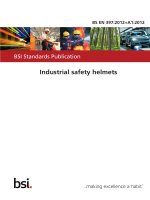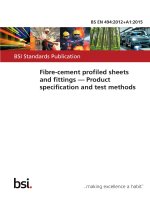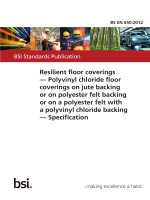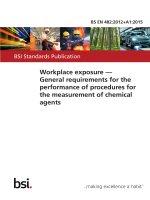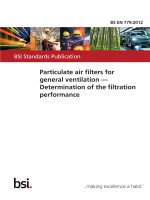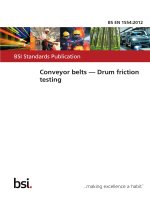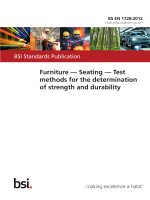Bsi bs en 62034 2012
Bạn đang xem bản rút gọn của tài liệu. Xem và tải ngay bản đầy đủ của tài liệu tại đây (1.17 MB, 32 trang )
BS EN 62034:2012
BSI Standards Publication
Automatic test systems
for battery powered
emergency escape
lighting
BRITISH STANDARD
BS EN 62034:2012
National foreword
This British Standard is the UK implementation of EN 62034:2012. It is
identical to IEC 62034:2012. It supersedes BS EN 62034:2006, which will be
withdrawn on 28 March 2015.
The UK participation in its preparation was entrusted by Technical Committee
CPL/34, Lamps and Related Equipment, to Subcommittee CPL/34/4,
Luminaires.
A list of organizations represented on this committee can be obtained on
request to its secretary.
This publication does not purport to include all the necessary provisions of a
contract. Users are responsible for its correct application.
© The British Standards Institution 2012
Published by BSI Standards Limited 2012
ISBN 978 0 580 67363 4
ICS 29.140.50
Compliance with a British Standard cannot confer immunity from
legal obligations.
This British Standard was published under the authority of the Standards
Policy and Strategy Committee on 30 June 2012.
Amendments issued since publication
Amd. No.
Date
Text affected
BS EN 62034:2012
EUROPEAN STANDARD
EN 62034
NORME EUROPÉENNE
May 2012
EUROPÄISCHE NORM
ICS 29.140.50
Supersedes EN 62034:2006
English version
Automatic test systems for battery powered emergency escape lighting
(IEC 62034:2012)
Systèmes automatiques d'essai pour
éclairage de sécurité sur batteries
(CEI 62034:2012)
Automatische Prüfsysteme für
batteriebetriebene Sicherheitsbeleuchtung
für Rettungswege
(IEC 62034:2012)
This European Standard was approved by CENELEC on 2012-03-28. CENELEC members are bound to comply
with the CEN/CENELEC Internal Regulations which stipulate the conditions for giving this European Standard
the status of a national standard without any alteration.
Up-to-date lists and bibliographical references concerning such national standards may be obtained on
application to the CEN-CENELEC Management Centre or to any CENELEC member.
This European Standard exists in three official versions (English, French, German). A version in any other
language made by translation under the responsibility of a CENELEC member into its own language and notified
to the CEN-CENELEC Management Centre has the same status as the official versions.
CENELEC members are the national electrotechnical committees of Austria, Belgium, Bulgaria, Croatia, Cyprus,
the Czech Republic, Denmark, Estonia, Finland, France, Germany, Greece, Hungary, Iceland, Ireland, Italy,
Latvia, Lithuania, Luxembourg, Malta, the Netherlands, Norway, Poland, Portugal, Romania, Slovakia, Slovenia,
Spain, Sweden, Switzerland, Turkey and the United Kingdom.
CENELEC
European Committee for Electrotechnical Standardization
Comité Européen de Normalisation Electrotechnique
Europäisches Komitee für Elektrotechnische Normung
Management Centre: Avenue Marnix 17, B - 1000 Brussels
© 2012 CENELEC -
All rights of exploitation in any form and by any means reserved worldwide for CENELEC members.
Ref. No. EN 62034:2012 E
BS EN 62034:2012
EN 62034:2012
-2-
Foreword
The text of document 34D/1040/FDIS, future edition 2 of IEC 62034, prepared by SC 34D, "Luminaires",
of IEC TC 34, "Lamps and related equipment" was submitted to the IEC-CENELEC parallel vote and
approved by CENELEC as EN 62034:2012.
The following dates are fixed:
•
•
latest date by which the document has
to be implemented at national level by
publication of an identical national
standard or by endorsement
latest date by which the national
standards conflicting with the
document have to be withdrawn
(dop)
2012-12-28
(dow)
2015-03-28
This document supersedes EN 62034:2006.
The main changes with respect to EN 62034:2006 are the improvement of the understanding of the
requirements in the various clauses and the compliance requirements listed below and the updating of
the normative references.
4.2 Monitoring of the timing circuit
4.3 Functional requirements
4.3.1 The automatic test system (ATS)
4.4.2 Intercommunications failure
4.4.4 Component failures
4.4.7 Software failure
5.1 Functional test
5.2 Duration test
6.2.2 Timing accuracy
6.3.2.2 Testing alternate luminaires
6.3.3.4 Limited duration test
7.1 General
Attention is drawn to the possibility that some of the elements of this document may be the subject of
patent rights. CENELEC [and/or CEN] shall not be held responsible for identifying any or all such patent
rights.
-3-
BS EN 62034:2012
EN 62034:2012
Endorsement notice
The text of the International Standard IEC 62034:2012 was approved by CENELEC as a European
Standard without any modification.
In the official version, for Bibliography, the following notes have to be added for the standards indicated:
IEC 61347-2-7
NOTE Harmonized as EN 61347-2-7.
IEC 61347-2-11
NOTE Harmonized as EN 61347-2-11.
BS EN 62034:2012
EN 62034:2012
-4-
Annex ZA
(normative)
Normative references to international publications
with their corresponding European publications
The following documents, in whole or in part, are normatively referenced in this document and are
indispensable for its application. For dated references, only the edition cited applies. For undated
references, the latest edition of the referenced document (including any amendments) applies.
NOTE When an international publication has been modified by common modifications, indicated by (mod), the relevant EN/HD
applies.
Publication
Year
Title
IEC 60073
-
Basic and safety principles for man-machine EN 60073
interface, marking and identification - Coding
principles for indicators and actuators
-
IEC 60598-1
-
Luminaires Part 1: General requirements and tests
EN 60598-1
-
IEC 60598-2-22
-
Luminaires Part 2-22: Particular requirements Luminaires for emergency lighting
EN 60598-2-22
-
IEC 61347-1
-
Lamp controlgear Part 1: General and safety requirements
EN 61347-1
-
IEC 61547
-
Equipment for general lighting purposes EMC immunity requirements
EN 61547
-
EN/HD
Year
–2–
BS EN 62034:2012
62034 © IEC:2012
CONTENTS
INTRODUCTION ................................................................................................................... 6
1
Scope ............................................................................................................................ 7
2
Normative references ..................................................................................................... 7
3
Terms and definitions ..................................................................................................... 7
4
Requirements ................................................................................................................. 9
4.1
4.2
4.3
5
6
Safety, construction and installation instructions ..................................................... 9
Monitoring of the timing circuit ............................................................................... 9
Functional requirements ........................................................................................ 9
4.3.1 The automatic test system (ATS) ................................................................ 9
4.3.2 Emergency battery supply ........................................................................ 10
4.3.3 Lamps tested in the emergency mode ....................................................... 10
4.3.4 Maintained luminaires tested in emergency mode and in normal
mains condition ........................................................................................ 10
4.4 System integrity ................................................................................................... 10
4.4.1 Protection against system part failures and faults ..................................... 10
4.4.2 Intercommunications failure ...................................................................... 11
4.4.3 System interconnection ............................................................................ 11
4.4.4 Component failures .................................................................................. 11
4.4.5 System parts compatibility ........................................................................ 11
4.4.6 Electromagnetic immunity of the ATS ....................................................... 12
4.4.7 Software failure ........................................................................................ 12
4.5 Test of emergency lamp(s) ................................................................................... 12
Test duration and interval ............................................................................................. 13
5.1 Functional test ..................................................................................................... 13
5.2 Duration test ........................................................................................................ 13
Protection of a building during the periods of test and subsequent recharge of the
emergency lighting system ............................................................................................ 14
6.1
6.2
7
General ............................................................................................................... 14
Accuracy and protection of timing periods ............................................................ 14
6.2.1 General ................................................................................................... 14
6.2.2 Timing accuracy ....................................................................................... 14
6.2.3 Protection of timing function ..................................................................... 14
6.3 Requirements for premises that may be occupied during test and recharge
periods ................................................................................................................ 15
6.3.1 General ................................................................................................... 15
6.3.2 Testing of self-contained luminaires ......................................................... 15
6.3.3 Test of centrally powered systems ............................................................ 16
6.3.4 Automatic test recording facilities ............................................................. 17
Indication and recording of results of tests that the equipment has to perform ................ 17
7.1
7.2
7.3
Annex A
General ............................................................................................................... 17
Indication ............................................................................................................ 18
Recording ............................................................................................................ 18
(informative) Examples of typical automatic test systems ...................................... 19
Annex B (normative) Classification of ATS types ................................................................ 24
Annex C (informative) Example of guidance for the use of ATS systems ............................. 25
BS EN 62034:2012
62034 © IEC:2012
–3–
Bibliography ....................................................................................................................... 26
Figure A.1 – Stand-alone, self-contained luminaire with automatic test facilities ................... 19
Figure A.2 – Direct connection between luminaires and remote panel .................................. 20
Figure A.3 – Alternative system where luminaire's connection is marshalled by a
connection box for transmission to remote indicators and control panel ................................ 21
Figure A.4 – Direct connection between luminaires and remote panel .................................. 22
Table A.1 – Standards conformity guide .............................................................................. 20
Table A.2 – Standards conformity guide .............................................................................. 22
Table A.3 – Standards conformity guide .............................................................................. 23
Table B.1 – Minimum function according to the ATS type ..................................................... 24
Table C.1 – Suitable ATS systems for different occupancy of premises ................................ 25
–6–
BS EN 62034:2012
62034 © IEC:2012
INTRODUCTION
Emergency lighting systems are a safety related product; their correct performance can only
be assured by systematic testing and maintenance. Conventional techniques for testing are
reliant upon manual testing procedures, and are highly susceptible to neglect. These
limitations of conventional techniques can be overcome by automating the testing process. It
is essential that automatic testing systems for emergency luminaires schedule tests reliably,
and provide timely notification of failures or degradation of performance.
Automatic test systems (ATS) will still require manual intervention to correct faults when they
are identified, and procedures should be put in place for such intervention. These systems
provide information to assist users to manage risk on their premises.
Automatic test systems for emergency escape lighting assist the operator of the building by
showing the results of tests that will have been made at prescribed intervals, without
disrupting any other electrical services. It is essential that the notification of failures or
reduction in performance be given at the earliest opportunity to enable the emergency escape
system to be restored to full operation.
The automatic test system will provide those responsible for an emergency lighting installation
with information to enable them to ensure that the installed luminaires operate correctly when
required.
The automatic test system may be part of a building management system (BMS) for making
the emergency lighting tests; this standard would only apply to the emergency lighting testing
part of a BMS.
A visual check of system components and indicators should be included in the routine of
safety staff. This check should be made regularly to ensure that the emergency luminaire is
present and intact, with lamps and indicators working and visible i.e. not obscured, covered or
painted.
BS EN 62034:2012
62034 © IEC:2012
–7–
AUTOMATIC TEST SYSTEMS FOR BATTERY POWERED
EMERGENCY ESCAPE LIGHTING
1
Scope
This International Standard specifies the basic performance and safety requirements for
individual products and components that are incorporated into automatic test systems for use
with emergency lighting systems on supply voltages not exceeding 1 000 V.
This standard also specifies the required functionality of a complete automatic test system for
an emergency lighting system.
This standard is applicable to testing systems consisting of a number of emergency lighting
self-contained luminaires or a central battery with associated emergency lighting luminaires.
NOTE Manual test facilities that rely on manual initiation and/or visual inspection of the lamp condition are
outside the scope of this standard.
2
Normative references
The following referenced documents are indispensable for the application of this document.
For dated references, only the edition cited applies. For undated references, the latest edition
of the referenced document (including any amendments) applies.
IEC 60073, Basic and safety principles for man-machine interface, marking and identification
– Coding principles for indicators and actuators
IEC 60598-1, Luminaires – Part 1: General requirements and tests
IEC 60598-2-22, Luminaires – Part 2-22: Particular requirements – Luminaires for emergency
lighting
IEC 61347-1, Lamp control gear – Part 1: General and safety requirements
IEC 61547, Equipment for general lighting purposes – EMC immunity requirements
3
Terms and definitions
For the purposes of this document, the terms and definitions given in IEC 60598-2-22 as well
as the following apply.
3.1
automatic test system
ATS
automated test system that may be manually initiated, consisting of parts (such as timers,
current detectors, light detectors, changeover switches) which, when connected together,
make a system that can carry out the routine testing requirements of emergency lighting
luminaires, and indicate the test results
–8–
BS EN 62034:2012
62034 © IEC:2012
3.2
self-contained luminaires with ATS
emergency luminaire that is self-contained with built-in testing facilities to perform tests and
indicate the test results
NOTE
Examples of self-contained luminaires are shown in Annex A.
3.3
self-contained luminaire system
system that performs tests on one or more self-contained emergency luminaires, which is
connected to a remote panel giving a proper indication of results
NOTE
Examples of a self-contained luminaire system are shown in Annex A.
3.4
centrally powered luminaire system
system that performs tests on one or more emergency luminaires, which is connected to a
central power supply system or a remote power supply system and giving a proper indication
of results
NOTE
Examples of a centrally powered luminaire system are shown in Annex A.
3.5
remote panel
part of a system that receives and/or sends information from and/or to the emergency lighting
luminaires, and may also indicate the test results
3.6
functional test
test to check the integrity of the circuit and the correct operation of a lamp, a changeover
device and battery emergency power supply
3.7
duration test
test to check if the battery emergency power supply source supplies the system within the
limits of rated duration of emergency operation
3.8
alternate luminaires
luminaires configured so that tests conducted by the ATS are not made on two adjacent
luminaires at the same time
3.9
test facility
main testing and recording device that may consist of a remote panel and/or computerized
system, which facilitates and controls the manual and automatic testing and recording of
relevant information, and has the ability to indicate test results in a visual and/or printed form
3.10
test sequence
sequence of the test or simulation that the ATS carried out during the test period
3.11
test period
interval of time where the ATS perform the test sequence on the luminaire
3.12
polling rate
rate at which a unit is interrogated by the control system
BS EN 62034:2012
62034 © IEC:2012
–9–
3.13
changeover device
device which provides a switchover operation of the lamps from normal operation control gear
to emergency control gear
4
Requirements
4.1
Safety, construction and installation instructions
All parts of the ATS shall conform to the requirements of IEC 60598-1 and IEC 60598-2-22
where these are appropriate.
NOTE 1
Guidance for the appropriate application of standards for typical systems is provided in Annex A.
The design and construction of the ATS shall ensure that only authorized personnel can
change the test duration and the frequency of tests.
The manufacturer shall include installation instructions for the ATS, which shall define any
limits of the size and compatibility of the ATS.
In the installation instructions, manufacturers shall advise the type of emergency luminaires
for which the ATS is designed.
Compliance is checked by inspection of the manufacturer’s instructions and/or of the
instruction sheet provided by the manufacturer.
The ATS shall be classified and marked according to one of the type stated in Annex B.
NOTE 2 Test circuit components may be installed within or adjacent to either self-contained or centrally powered
luminaires. Additional components may be located in a remote panel.
4.2
Monitoring of the timing circuit
In all ATS types (see Annex B), any failure of the progress of the test sequence of the ATS
shall be indicated locally on the luminaire and/or on the remote panel as applicable to the
ATS type.
NOTE The monitoring of the timing circuit is essential as the duration of testing periods and the intervals between
them need to be ensured and maintained.
This failure shall be tested by simulating a fault that interrupts the progress of the test
sequence or any other procedure that can be agreed with the system designer/manufacturer
and the test laboratory to demonstrate compliance with this clause, and checking that the
failure is indicated locally on the luminaire and/or on the remote panel as applicable to the
ATS type.
Compliance is checked by testing a sample according to the instructions provided by the
manufacturer.
4.3
Functional requirements
NOTE
The tests of 4.3 and 4.4 should be carried out before the tests of Clause 5.
4.3.1
The automatic test system (ATS)
The ATS shall check the functional operation of the emergency lighting luminaires and
associated power supplies, at intervals and for the duration specified in Clause 5, to identify
any faults that would impair their operational duty. Any faults shall be indicated or reported
– 10 –
BS EN 62034:2012
62034 © IEC:2012
within 24 h after their detection. For types P, ER, PER and PERC, verification for a fully
loaded system may be made by extrapolation of the polling rate measured on the individual
unit.
NOTE
Types P, ER, PER and PERC are defined in Annex B.
Compliance is checked by inspection and prescribed test (see Clause 5).
4.3.2
Emergency battery supply
The test system shall check and indicate if the emergency battery supply has failed.
Compliance is checked by disconnecting the battery during the test sequence – a fault shall
be indicated within the test period.
4.3.3
Lamps tested in the emergency mode
The test system shall check that any changeover device, where fitted, has powered the lamp
from the emergency power supply.
NOTE The full load from the battery is equivalent to the maximum discharge load current of the circuit, excluding
the starting period.
Compliance is checked as follows:
•
if the charging current to the battery is higher than 15 % of the full load, the charger shall
be disconnected during the test;
•
if the charging current is between 5 % and 15 % of the full load, the charger shall be
compensated during the test;
•
if the charging current is less than 5 % of the full load, the charger should be ignored
during the test.
4.3.4
Maintained luminaires tested in emergency mode and in normal mains
condition
For maintained luminaire that do not have a changeover device, the test system shall check
that the lamp operates correctly in both the normal mains supply and failed supply conditions.
For maintained luminaries with a changeover device, test shall be carried out according to
4.3.3 with the monitoring of the battery current or output voltage to check the changeover.
Compliance is checked by inspection of the test system when the maintained lamps are
operating.
4.4
4.4.1
System integrity
Protection against system part failures and faults
Any single fault or part-failure that occurs in the ATS, or within one of the system parts, shall
not affect the emergency operation of the ATS, in accordance with the requirements of 4.4.2
to 4.4.7.
Compliance is checked by inspection and the requirements of 4.4.2 to 4.4.7.
BS EN 62034:2012
62034 © IEC:2012
4.4.2
– 11 –
Intercommunications failure
Any failure of intercommunication between the parts of ATS system, as defined in 3.3 and 3.4,
shall not inhibit the emergency operation of the luminaires connected to the ATS, or initiate an
unwanted test. Furthermore, in the case P, ER, PER and PERC ATS types (see Annex B),
any failure of intercommunication between ATS parts shall be indicated as a fault on the
remote panel within 24 h of the failure occurring.
For this test, the communication shall be interrupted by the appropriate means (according to
the manufacturer’s instructions). The following checks are then made:
–
no unwanted test is initiated;
–
the emergency operation of the luminaires operates if the normal supply is switched off;
–
the failure of the interconnection between ATS parts is indicated as a fault on the remote
panel within 24 h.
NOTE
4.4.3
Subclauses 22.3.18 and 22.3.21 of IEC 60598-2-22 are to be considered.
System interconnection
The operation of luminaires in the emergency mode shall not be affected by any faults in the
wiring of the interconnections of the ATS, including a short circuit, contacts to earth or an
interruption in the wiring of the ATS supply or communications wiring. No unwanted test shall
be initiated. The test shall only operate at correct times; other tests would put the system’s
emergency duty at risk.
Compliance is checked by simulation of these wiring faults to the ATS.
NOTE Short circuit connections between supply and communications wiring are not included in the test if they are
separated by double insulation.
4.4.4
Component failures
The failure of any single part within the ATS shall not inhibit the emergency operation of more
than one of the luminaires connected to the ATS, or initiate an unwanted test.
For component failures that mimic a control signal or inhibit an emergency operation, the
requirements of IEC 61347-1 apply.
NOTE For the ATS systems and devices, it may be appropriate to seek the advice of the control gear
manufacturers with respect to selection of the internal parts that are most likely to cause a failure against the
requirements of this test.
4.4.5
System parts compatibility
The individual parts, control gear and other electronic devices selected to form an ATS shall
be proven to be compatible with each other.
It shall be the responsibility of the system designer to ensure ATS component and procedure
compatibility. The manufacturer of ATS components/system shall provide details of
compatible system components.
– 12 –
BS EN 62034:2012
62034 © IEC:2012
The manufacturer shall declare:
–
the limits of the installation in the instruction sheet, length of the cabling, quantity of
luminaires;
–
in the technical folder: the justification of compatibility between any part within the ATS.
NOTE Conformity of individual parts against the requirements of relevant IEC or regional standards cannot be
relied on to completely ensure compatibility in this instance. EMC, voltage transfer, switching phenomena, etc.
should be considered.
4.4.6
Electromagnetic immunity of the ATS
Electromagnetic phenomena shall not inhibit operation of the ATS or initiate an unwanted test.
Compliance is checked by the tests of IEC 61547 applying the requirements and compliance
criteria for emergency lighting luminaires. The IEC 61547 test report shall be provided either
by the manufacturer or a third part test house.
In addition, the supply voltage dips and interruptions tests shall be conducted in accordance
with IEC 61547. During testing, operation of the ATS shall not be affected, and no unwanted
tests shall be initiated.
4.4.7
Software failure
The correct operation of ATS software shall be proven.
It shall be the responsibility of the system designer to conduct sufficient investigations and
operational trials to ensure the correct operation of software and failure protection. Detailed
software design documentation, for example functional descriptions of the main programme
flow, flowcharts for the software operation, fault mode analysis, how the software and
hardware interact etc., shall be provided by the designer/manufacturer in order that the test
laboratory can ensure the reliability of the software.
Any software failure shall not inhibit the emergency operation of more than one of the
luminaires connected to the system, and shall not initiate an unwanted test.
NOTE For product certification (e.g. third party testing), the designer/manufacturer should have available detailed
software design documentation, including functional descriptions of the main program flow, including flow charts
fault mode analysis, etc. and how the software and hardware interact in order that the test laboratory can ensure
the reliability of the software.
Compliance is checked by inspection.
4.5
Test of emergency lamp(s)
The ATS shall check and indicate if the emergency lamp(s) do not operate in emergency
mode. In the case of P, ER, PER and PERC ATS types (see Annex B), the indication shall be
on the remote panel and possibly on the luminaries.
Compliance is checked by:
a) removal of the emergency incandescent lamp during test; and
b) the fault abnormal conditions of IEC 60598-1 for fluorescent, discharge lamps or any other
appropriate emergency lamp technology, e.g. LED.
A fault indication shall be given locally on the luminaire and/or on the remote panel as
applicable for a) and b) above.
BS EN 62034:2012
62034 © IEC:2012
5
– 13 –
Test duration and interval
5.1
Functional test
A functional test shall be performed at least once a month. For batteries, repeated tests may
entail a loss of capacity. For this reason the test duration shall be sufficient to check the
illumination of the lamp, but shall not be longer than 10 % of rated duration. For batteries that
exhibit loss of capacity from repeated short duration discharges, the total of these test
durations shall not exceed 10 % of rated duration in a month. The rated duration is defined in
IEC 60598-2-22.
NOTE 1 Attention is drawn to national regulations that may dictate the testing frequency and types of testing
required.
NOTE 2 This test gives the earliest warning of luminaire failure that is consistent with luminaire component life.
Manual logging of fault conditions, when required, should be actioned within one month or in line with national
regulations. Attention is drawn to national regulations that may require other test conditions.
NOTE 3 Proven compatibility of lamps, lamp-control gear, and the automatic test regime is the responsibility of
the system provider.
If a mains supply failure occurs before a functional test and within such a time that the battery
could not be re-charged sufficiently to run a successful functional test, then the test should be
postponed until the battery is recharged sufficiently to perform the test after the restoration of
the mains supply up to a period of 24 h. The compatibility of the final ATS parts shall ensure
their reliable operation. In the case of P, ER, PER and PERC ATS types (see Annex B) in the
event that a functional test is postponed, indication of the pending test shall be given on the
remote panel. Where applicable, the test function and test postponement functions are to be
demonstrated. If a mains supply failure occurs whilst a functional test is in progress, the test
shall be postponed and the system shall enter emergency operation. Following restoration of
the mains supply, a postponed functional test shall re-commence automatically as soon as
conditions permit. If the duration of the functional test is less than 1 % of the rated duration,
then the postponed function is not required.
The conformity of timing requirements including the periodicity and details of the tests
(hierarchy, managements of the test delays) is checked by inspection of the manufacturer’s
declaration and the technical file provided by the manufacturer.
NOTE 4 It is known that non-standardized low-power operation of fluorescent lamps can be damaging to some
types/makes of fluorescent lamp.
5.2
Duration test
For full rated duration, a test shall be performed according to the manufacturer’s instructions
at the commissioning of the ATS, and repeated automatically at least annually.
NOTE 1 The test should check that the emergency lamp(s) are illuminated for their duration of emergency
operation for the application or equivalent battery discharge rate.
NOTE 2 Attention is drawn to national regulations that may dictate the testing frequency and types of testing
required.
Random automatically-initiated rated duration tests shall be carried out within 52 weeks after
commissioning.
NOTE 3
For the use of random initiated ATS, careful consideration may be required for some applications.
The test duration shall not be able to be changed by unauthorized persons.
A duration test shall only be started when the battery supply is fully charged. If a mains supply
failure occurs whilst a duration test is in progress, the test shall be postponed and the system
shall enter emergency operation. Following restoration of the mains supply, a postponed
duration test shall re-commence automatically when the battery supply is fully re-charged.
– 14 –
BS EN 62034:2012
62034 © IEC:2012
The design of the system should ensure this, for example by allowing a fixed delay time for
the battery supply to re-charge or by monitoring the real-time charge state of the battery). In
the case of P, ER, PER and PERC ATS types (see Annex B) in the event that a duration test
is postponed, indication of the pending test shall be given on the remote panel.
NOTE 4 In some locations, the duration test should be done always at the same settled time. In this case, the
postponed test should be launched when the battery is fully charged and at the same time as the “programmed test
+ n×24 h, where n is an integer number taking in account the time when the battery is fully charged”.
Compliance is checked, where applicable, by confirming that the test function and test
postponement functions have functioned correctly.
Conformity of timing requirements, details of operation, declaration and verification through
detailed examination of software shall be provided by manufacturers.
6
Protection of a building during the periods of test and subsequent recharge
of the emergency lighting system
6.1
General
This clause applies to all ATS types where appropriate time and dates are used to programme
the testing sequences. Manufacturer's declaration and appropriate document evidence shall
be provided.
ATS shall be designed to minimize the effects of a mains supply failure on the availability of
the emergency lighting when batteries are only partially charged as a result of a duration test
and subsequent battery recharge.
If there is a possibility that a building could be occupied during the duration test, only the
procedures in 6.3 shall be used.
6.2
Accuracy and protection of timing periods
6.2.1
General
The accuracy and the function of an ATS timer shall conform to the requirements of 6.2.2 and
6.2.3.
6.2.2
Timing accuracy
The ATS timer consists of two timing requirements – timing of test interval and timing of test
function. The accuracy of the timing of the test interval shall be tested to ensure that it has an
accuracy of ±75 s per week. The accuracy of the timing of the test function shall be tested to
ensure that it has the same accuracy as the timing of the test interval.
Compliance shall be checked by the periodicity of two successive functional tests. This
periodicity shall be stated in the instruction sheet of the manufacturer.
6.2.3
Protection of timing function
The timing function shall be retained through periods of mains supply failure or interruption for
up to 7 days, unless:
a)
the ATS automatically restores separated timings of alternate luminaires;
b)
the ATS is designed to provide automatic restoring for testing alternative luminaires or
automatic initiation of test function.
BS EN 62034:2012
62034 © IEC:2012
– 15 –
Operating instructions shall state that the ATS be re-commissioned following extended
periods of mains supply failure. The extended period of mains supply failure shall be specified
by the manufacturer in the operating instructions, and shall be greater than 7 days.
Compliance is checked by:
–
the simulation of a mains failure, and
–
the verification of the correct functioning of the timing.
This last compliance is checked by measuring the periodicity of the functional test.
After a charging cycle of 24 h at 0,9 times the rated supply voltage, the time and the date of
the first test which occurred is noted.
Switch off the mains of the ATS during seven days.
Switch on the mains of the ATS.
The time and date of the first functional test which occurred is noted after the restoration of
the mains supply. The periodicity of the test declared by the manufacturer is checked.
In the case of a periodicity less than 1 week + 24 h, the periodicity between the first test
happening after the restoration of the normal supply and the following test is checked. The
tests shall be performed at the time and date initially scheduled before the mains interruption.
6.3
Requirements for premises that may be occupied during test and recharge
periods
6.3.1
General
Systems designed for installation in premises which may be occupied during the duration test
and subsequent battery recharge shall conform to the precautionary measures of either
a) 6.3.2 for systems of self-contained luminaires; or
b) 6.3.3 for centrally supplied systems.
NOTE At the design stage, it should be reinforced that the correct type of automatic test system should be
selected and set up to ensure testing takes place at periods of minimum risk.
6.3.2
6.3.2.1
Testing of self-contained luminaires
General
Self-contained emergency luminaires shall be tested by one of the procedures in 6.3.2.2,
6.3.2.3 or 6.3.2.4 to keep a security level of the emergency lighting in case of supply failure.
6.3.2.2
Testing alternate luminaires
The ATS shall be designed to test and allow full recharge of a luminaire prior to the testing of
the next alternate luminaire. Installation information shall be provided for each ATS by the
ATS provider.
The manufacturer shall provide sufficient information for the setting of the ATS timers to
ensure that the timing interval between adjacent luminaires is sufficiently long to prevent
drifting into the same test period.
– 16 –
BS EN 62034:2012
62034 © IEC:2012
NOTE 1 In some countries, random testing of self-contained luminaires is acceptable. In this case, this
requirement does not apply.
NOTE 2 All the other requirements of the test including timing and checking operation should be carried out
automatically.
Compliance is checked by confirming that the sequence of testing does not affect alternate
luminaires during the same test period. This is checked by inspection of the documentation of
the manufacturer.
6.3.2.3
Manual initiation of the test function
In case of a non-automatic initiation of the test, manual initiation of the test shall be
acceptable providing that there is a visible fault indication (as described in 7.2), or records of
previous tests which indicate that the discharge test has not been carried out within the
previous 12-month period.
NOTE 1 After the manual initiation, the operation of the test is automatic, including return to normal operation and
fault reporting.
NOTE 2
test.
The purpose of these requirements is to ensure the safety of the premises when carrying out the duration
Compliance is checked by inspection.
6.3.2.4
Automatic initiation of test function
Automatically initiated tests shall perform the tests in accordance with Clause 5. However, the
duration test shall be carried out within 52 weeks after commissioning. This requirement is
applicable only in combination with 6.3.2.2 for premises which may be occupied during the
test and the subsequent recharging period.
Random automatically-initiated rated duration tests shall be carried out within 52 weeks after
commissioning.
NOTE The operating instructions should draw attention to the possibility of adjacent luminaires being tested
simultaneously. This should include the points of emphasis and emergency exit signs along the escape route.
Compliance is checked by inspection.
6.3.3
6.3.3.1
Test of centrally powered systems
General
Centrally powered ATS’s shall provide facilities to enable the ATS to be tested by:
–
one of the procedures in 6.3.3.2, or 6.3.3.4 to keep a security level of some emergency
lighting in case of mains supply failure;
–
and optionally 6.3.3.3 in case of a manual initiation of the test.
6.3.3.2
Dual batteries
If the ATS is equipped with dual parallel batteries, they shall be arranged to enable the ATS
to be tested in two sections, where each section shall be capable of providing illumination
while the other is discharged.
NOTE 1
This system also enables some luminaires to operate while the batteries are being serviced or replaced.
Compliance is checked by the alternate operation of the dual batteries, allowing the batteries
to recharge for 24 h between the two tests.
BS EN 62034:2012
62034 © IEC:2012
– 17 –
NOTE 2 The location of luminaires connected to the fully charged battery should ensure that if a mains supply
failure occurs at any time in the test cycles, no part of the escape route will be in total darkness.
6.3.3.3
Manual initiation of the test function
Manual initiation of the test shall be acceptable providing that there is a visible fault indication,
(as described in 7.2), or records of previous tests which indicate that the duration test has not
been carried out within the previous 12-month period.
NOTE 1 After the manual initiation, the operation of the test is automatic including return to normal operation and
fault reporting.
NOTE 2 Automatic initiation of the test is acceptable when not carried out randomly and at times of low risk. This
is only accepted if it can be guaranteed that the building would not be in use for a period of 24 h after the
automatic discharge.
Compliance is checked by inspection.
6.3.3.4
Limited duration test
The limited duration test shall be performed for two-thirds of the rated duration. The central
emergency power supply system shall be automatically checked to ensure that the battery has
not discharged to a lower voltage than is required for a discharge of two-thirds of the rated
duration.
The manufacturer shall provide a battery declaration and details of the test requirements
which includes the minimum battery voltage for the limited duration test for a discharge of
two-thirds of the rated duration.
6.3.4
Automatic test recording facilities
Where an ATS with a recording facility is used to monitor the status of the installation of the
emergency lighting, the ATS shall indicate the results of testing in accordance with Clause 4,
with an indication of the location of any fault.
7
7.1
Indication and recording of results of tests that the equipment has to
perform
General
The ATS shall give an indication of all test results. The ATS test results indicator shall be
designed and constructed so that the indication of the failure of a duration test shall not be
cancelled out by a subsequent successful functional test.
During a mains failure condition, the results of a test failure shall be retained for at least one
week after the mains failure and be indicated when the mains supply is resumed, or the ATS
shall automatically repeat the failed test after recharging for a period of 24 h. For P and S
types, the records are displayed by local indicators.
Complete the test specification as follows:
–
create a failure of the duration test according to the manufacturer's instructions;
–
initiate a functional test according to the manufacturer's instructions;
–
check that the result of the duration test has not been influenced by this last test and
switch off during one week;
–
restore the supply source and check that the failure is retained.
If not, check that a duration test is initiated automatically after 24 h of charging.
– 18 –
BS EN 62034:2012
62034 © IEC:2012
Compliance is checked by inspection of records/log.
7.2
Indication
Each ATS shall indicate whether the mains supply is functioning normally or has failed. The
results of all tests shall be indicated. If the indicator lamps are used, they shall comply with
IEC 60073.
NOTE 1
Flashing indicators and character displays are also acceptable for use as test indicators.
NOTE 2 The test indicator may be the same device as the indicator required by IEC 60598-2-22, provided it does
not contradict the requirement defined in IEC 60598-2-22.
NOTE 3 The mains supply failure may be indicated by the extinction of the indicator lamp defined in
IEC 60598-2-22.
Compliance is checked by inspection.
7.3
Recording
Self-contained luminaires with built-in automatic testing facilities (see 3.2) shall comprise a
visual indication of the results of the test, which may be simplified to illuminated indicators.
Fault indicators shall only be reset to their non-fault status by correction of the fault.
For central monitored automatic test systems (see 3.3 and 3.4), the results of the tests shall
be stored electronically with either a visual warning or a visual and audible warning of a
failure. Test histories shall be available as both a visual and a printable record.
Compliance is checked by inspection.
BS EN 62034:2012
62034 © IEC:2012
– 19 –
Annex A
(informative)
Examples of typical automatic test systems
A.1
General
This annex contains examples of typical automatic test systems (ATS) for battery-powered
emergency escape lighting, and includes guidance regarding conformity that is required under
4.1 of this standard, for the separate component parts of a system.
Due to the nature of ATS, the actual components and the configuration of components will
vary from system to system as indicated in Figures A.1, A.2, A.3 and A.4. Tables A.1 to A.3
give the standards conformity guide.
A.2
Self-contained luminaires
Switched and unswitched supply
Luminaire
Indicator
Emergency
lighting
ballast/charger
Internal control gear
Test device
IEC
125/12
Figure A.1 – Stand-alone, self-contained luminaire with automatic test facilities
BS EN 62034:2012
62034 © IEC:2012
– 20 –
Table A.1 – Standards conformity guide
Part/Component
A.3
Relevant IEC standards
Luminaire
IEC 60598-2-22 and IEC 62034
Ballast
IEC 61347-2-7
Test circuit
IEC 61347-2-11 and IEC 62034
Multi-luminaire system with central monitoring for self-contained
emergency luminaires
Switched and unswitched supplies
Luminaire
Luminaire
Luminaire
Luminaire
Luminaire
Luminaire
Remote control
panel and fault
indicator
Luminaire
May be combined
as a single unit
Remote
monitoring and
control
computer
Ballast/charger
Test circuit
IEC
Figure A.2 – Direct connection between luminaires and remote panel
126/12
BS EN 62034:2012
62034 © IEC:2012
– 21 –
Switched and unswitched supplies
Luminaire
Communications
marshalling box
Luminaire
Luminaire
Luminaire
Luminaire
Communications
marshalling box
Luminaire
Remote control
panel and fault
indication
Luminaire
Ballast/charger
Internal control
Remote monitoring
and
control computer
Test device
IEC
127/12
Figure A.3 – Alternative system where luminaire's connection is marshalled by a
connection box for transmission to remote indicators and control panel
BS EN 62034:2012
62034 © IEC:2012
– 22 –
Table A.2 – Standards conformity guide
Part/Component
Standards
Luminaire
IEC 60598-2-22 and IEC 62034
Ballast
IEC 61347-2-7
Test circuit
IEC 61347-2-11 and IEC 62034
Marshalling box (Figure A.3)
IEC 61347-2-11 and IEC 62034
Control panel
IEC 61347-2-11 and IEC 62034
Computer
IEC 62034 (software only)
System (see Note 1)
IEC 62034
Communications wiring
IEC 62034
Connectors
Relevant IEC standard
NOTE 1 The system must be fully assembled with sufficient luminaires and other
components to allow the assessment of discrete component failures on the overall
operation of the system to be checked.
NOTE 2 Conformity to IEC 62034 can only be declared for a complete system and
not for component parts that has been inspected in isolation.
A.4
Central battery multi luminaire systems
Luminaire
Control
switching
device
Luminaire
Central power
supply unit
Luminaire
Luminaire
Luminaire
Luminaire
Test circuit activates
operation of the central
power supply unit by
simulating a supply failure
Luminaire
May be combined
as a single unit
Remote control
panel and fault
indicator
Remote
monitoring and
Control computer
IEC
Figure A.4 – Direct connection between luminaires and remote panel
128/12
